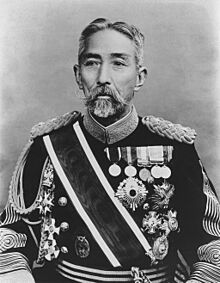Nozu Michitsura facts for kids
Quick facts for kids
Marquis
Nozu Michitsura
野津 道貫 |
|
|---|---|

Field Marshal The Marquis Nozu Michitsura
|
|
| Native name |
野津 道貫
|
| Born | December 17, 1840 Kagoshima, Satsuma Domain, Japan |
| Died | October 18, 1908 (aged 67) Tokyo, Japan |
| Allegiance | |
| Service/ |
|
| Years of service | 1861–1906 |
| Rank | field marshal |
| Commands held | Imperial Japanese Army |
| Battles/wars | |
| Awards |
|
Field Marshal The Marquis Nozu Michitsura (野津 道貫, 17 December 1840 – 18 October 1908) was a very important Japanese military leader. He became a field marshal and helped shape the early Imperial Japanese Army.
Contents
Nozu Michitsura's Early Life and Military Start
Nozu Michitsura was born in Kagoshima, Japan, in 1840. He was the second son in a family of samurai, but they were not high-ranking. From a young age, he studied Japanese swordsmanship under a famous teacher named Yakumaru Kaneyoshi.
Fighting in the Boshin War
Nozu's first big military experience was during the Boshin War. This war (1868-1869) was a major conflict in Japan. It led to the end of the old samurai government and brought the Emperor Meiji back to power. Nozu was a company commander during this time. He fought in many important battles, including the Battle of Toba–Fushimi, the Battle of Aizu, and the Battle of Hakodate.
Joining the New Imperial Japanese Army
After the Boshin War, Nozu moved to Tokyo. In 1871, he joined the new Imperial Japanese Army as a major. This army was just starting to form and was very different from the old samurai forces.
Rising Through the Ranks
Nozu quickly moved up the ranks. He became a lieutenant colonel in 1872 and a colonel in 1874. He was also made the chief of staff for the Imperial Guards Brigade.
In 1876, Nozu traveled to the United States. He visited the Centennial Exhibition in Philadelphia, which was a big world's fair.
The Satsuma Rebellion
Soon after returning to Japan, Nozu faced a difficult challenge. He had to fight against his own former clansmen from Satsuma. This was during the Satsuma Rebellion in 1877. This rebellion was led by former samurai who were unhappy with the new government. Nozu served as chief of staff for the 2nd Brigade during this conflict.
A Leader in the Imperial Army
In 1878, Nozu was promoted to major general. He then commanded the Tokyo Military District.
Studying Armies Abroad
In 1884, Nozu went on a year-long trip to Europe with War Minister Ōyama Iwao. They studied the military systems of different European countries. This trip helped Japan learn how to build a modern army.
While in Europe, Emperor Meiji gave Nozu the title of baron (danshaku). This was a special title in the kazoku peerage system, a new system of nobility in Japan.
More Promotions and Commands
After his trip, Nozu was sent to Beijing, Qing Dynasty China, as a military attaché in 1885. When he returned to Japan, he was promoted to lieutenant general. He then became the commander of the Hiroshima Military District.
In 1888, the Imperial Japanese Army was reorganized into divisions. This was based on advice from a German military expert, Jakob Meckel. Nozu was made the commander of the new IJA 5th Division.
Leading in Major Wars
Nozu's division saw action in the First Sino-Japanese War (1894-1895). This was a war between Japan and China. His division fought bravely at the Battle of Pyongyang (1894). In 1895, Nozu was promoted to full general. He took over from General Yamagata Aritomo as the commander-in-chief of the Japanese First Army in Manchuria. After the war, he was given the title of viscount (shishaku).
After the Sino-Japanese War
After the war, Nozu held several important military positions. He commanded the Imperial Guard Division and was the Inspector-General of Military Training. He also served as a Military Councilor, advising the government on military matters.
The Russo-Japanese War
When the Russo-Japanese War began in 1904, Nozu was given command of the Japanese Fourth Army. This army played a very important role in the Battle of Mukden, one of the largest land battles in history at that time.
At the end of the war, in January 1906, Nozu received the highest military rank: field marshal. His noble title was also upgraded to marquis (koshaku).
Later Life and Legacy
From 1907 until his death in 1908, Nozu served as a member of the House of Peers. This was a part of the Diet of Japan, Japan's parliament.
Nozu Michitsura received many honors for his service. These included the Order of the Golden Kite (1st class) and the Grand Cordon of the Supreme Order of the Chrysanthemum.
He passed away in October 1908 and is buried at the Aoyama Cemetery in Tokyo.

